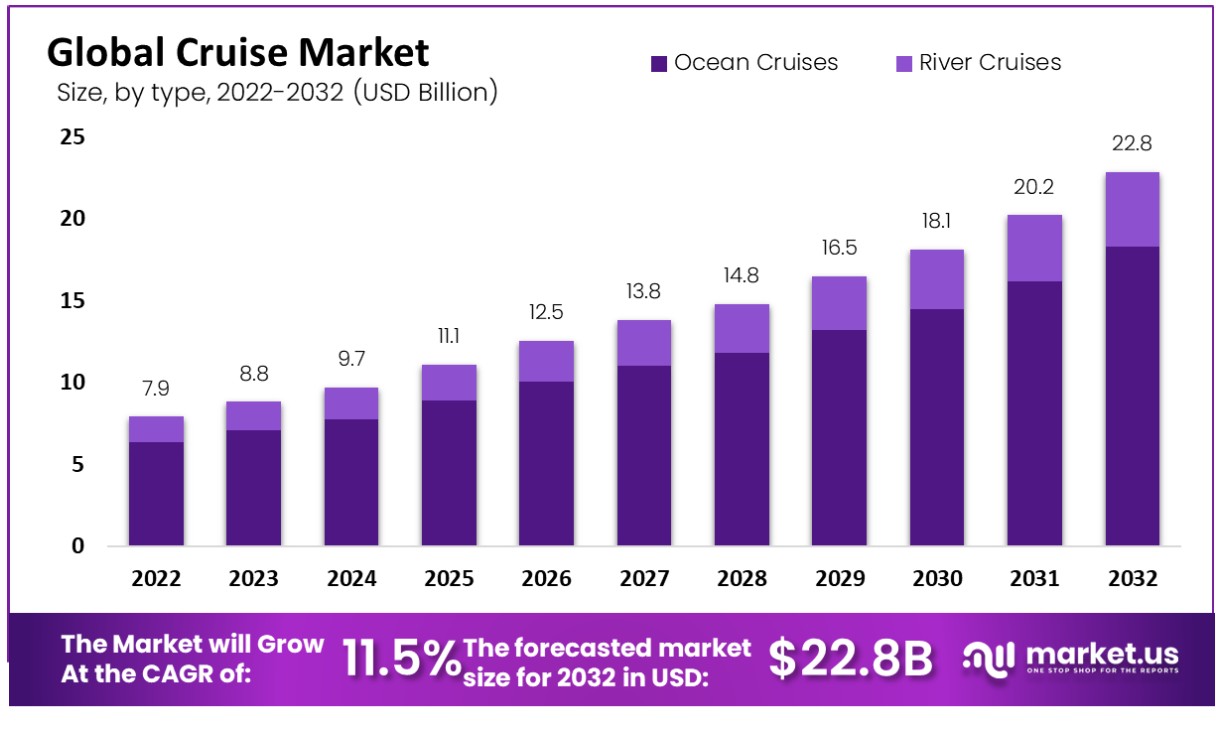Cruise Market Size ( USD 22.8 Billion by 2032) with 11.5% CAGR | According To Market.us

Page Contents
Published Via 11Press : The cruise market has seen significant growth over the past few decades. With a wide variety of destinations and activities available on board, cruises have become popular among travelers seeking a relaxing vacation with plenty of options for entertainment. The industry has also been able to reach new markets by expanding its offerings to families, couples, and solo travelers.
The Cruise Market size was valued to be worth USD 7.9 billion in 2022. From 2023 to 2032, it is estimated to reach USD 22.8 billion growing at a CAGR of 11.5%.
In recent years, the cruise market has experienced an increase in demand for luxury and expedition cruises. Luxury cruises offer high-end amenities such as personalized service, gourmet cuisine, and exclusive excursions while expedition cruises take passengers on adventures to remote locations such as Antarctica or the Galapagos Islands.
Despite facing challenges like safety concerns and environmental impact issues, the cruise market continues to thrive with new ships being launched every year. As technology advances, it will be interesting to see how the industry adapts to changing consumer expectations while maintaining its position as a top choice for vacationers around the world.
Request For Sample Report Here: https://market.us/report/cruise-market/request-sample/

Key Takeaway
- According to a 2022-2022 Cruise Market Analysis report, Ocean Cruises were dominating due to their increasing travel numbers and large capacities.
- North America led the market with 50% of revenues generated.
- Asia Pacific (APAC) is projected to experience the fastest projected compound annual growth rates among all regions.
Pioneering Possibilities: Generative AI's Journey in the Cruise Market
- Personalized cruise experiences: Generative AI can be used to create personalized cruise experiences for each passenger. For example, generative AI could be used to recommend activities and excursions that are tailored to each passenger's interests or to create a dining experience that is customized to each passenger's dietary restrictions.
- Virtual cruise tours: Generative AI can be used to create virtual cruise tours that allow passengers to explore a cruise ship or a destination before they book their trip. This could help passengers to make more informed decisions about their cruise, and it could also help to reduce the number of no-shows.
- Cruise ship design: Generative AI can be used to design new and innovative cruise ships that are more efficient, effective, and user-friendly. For example, generative AI could be used to design new types of cabins that are more spacious and comfortable or to develop new types of entertainment systems that are more engaging and interactive.
- Cruise ship operations: Generative AI can be used to improve the efficiency and effectiveness of cruise ship operations. For example, generative AI could be used to optimize the routing of cruise ships or to develop new ways to manage passenger flow.
Regional Snapshot
- North America: North America and, in particular, the United States, is one of the biggest cruise destinations in the world. The region is a favored destination for cruises that depart to various destinations such as destinations like the Caribbean, Alaska, and the Mediterranean. It has a strong infrastructure for cruises, including the major cruise lines operating from numerous ports on the west and east coasts.
- Europe: Europe is another important region in the market for cruises. Mediterranean cruises, that go to destinations like Italy, Greece, and Spain are very sought-after. Northern European cruises like cruises towards destinations like the Baltic Sea and Norwegian Fjords have also attracted a substantial quantity of travelers. Large European ports, like Barcelona, Venice, and Southampton are the ports of departure for a variety of cruises.
- Asia-Pacific: The Asia-Pacific region has seen significant expansion in the market for cruises in recent times. Regions like China, Japan, and Australia are seeing an increase in interest in cruises. Most popular destinations include Southeast Asia, the South Pacific as well as Alaska. The major cruise lines have set up their presence in this region and offer customized itineraries to meet the desires of Asian travelers.
- Latin America: The Caribbean is a popular destination to cruise, and draws many tourists coming from North America and Europe. Cruises to the Caribbean generally visit several islands and give visitors an opportunity to experience diverse cultures, relax on pristine beaches and enjoy water sports. Latin American countries, such as Mexico, Brazil, and Argentina can also be found in the cruise industry in the region.
- Middle East and Africa: The market for cruises within the Middle East and Africa is somewhat smaller than the other regions, yet it is expanding slowly. Dubai has become the most important hub for cruises and has several cruise companies providing itineraries within Dubai and the Arabian Gulf. South Africa and Egypt also draw cruise passengers, providing the chance to see ancient sites, wildlife, and of course, the Red Sea.
Directly Purchase a copy of the report | Quick Delivery Available – https://market.us/purchase-report/?report_id=22103
Drivers
- Increasing Consumer Demand: The cruise market is driven by the growing consumer demand for cruise vacations. Cruise travel offers a unique experience of visiting multiple destinations while enjoying onboard amenities, entertainment, and dining options.
- Affordable Luxury: Cruises provide an affordable option for travelers to experience luxury and convenience. All-inclusive packages, which cover accommodations, meals, entertainment, and transportation between destinations, make cruising an attractive choice for a wide range of travelers.
- Expanding Middle Class and Aging Population: The growth of the middle-class population, particularly in emerging economies, has led to increased disposable income and a higher propensity to travel. Additionally, the aging population seeks leisure and vacation options, with cruises offering convenient and comfortable travel experiences.
- Destination Variety: Cruises offer a diverse range of destinations, from popular coastal regions to remote and exotic locations. This variety attracts travelers seeking new experiences, cultural immersion, and the opportunity to explore multiple destinations in a single trip.
- Onboard Amenities and Activities: Modern cruise ships provide a wide range of onboard amenities and activities, including restaurants, bars, theaters, casinos, pools, spas, fitness centers, and entertainment options. These offerings contribute to the appeal of cruising as a complete vacation experience.
Restraints
- Seasonality and Weather Dependence: The cruise industry is often influenced by seasonal demand, with certain destinations experiencing peak travel periods. Additionally, adverse weather conditions, such as hurricanes or storms, can impact cruise itineraries and pose challenges for operators.
- Safety and Security Concerns: Safety and security issues, such as incidents of piracy, outbreaks of contagious diseases, or accidents at sea, can affect consumer confidence in cruise travel. Cruise operators must prioritize passenger safety and implement robust security measures to mitigate risks.
- Environmental Impact and Sustainability: The cruise industry faces scrutiny regarding its environmental impact, including issues such as air and water pollution, waste management, and carbon emissions. Increasing environmental regulations and public awareness necessitate sustainable practices and investments in cleaner technologies.
Opportunities
- Emerging Markets: There is significant potential for growth in emerging markets, such as Asia-Pacific and Latin America. Increasing disposable incomes, changing travel preferences, and infrastructure development present opportunities for cruise operators to expand their market presence.
- Expedition and Adventure Cruising: There is a growing demand for expedition and adventure cruises, catering to travelers seeking unique and immersive experiences in remote and environmentally sensitive regions. These cruises offer opportunities for wildlife viewing, nature exploration, and adventure activities.
- Multigenerational and Family Travel: The cruise market can capitalize on the growing trend of multigenerational and family travel. Cruise ships provide a range of amenities and activities suitable for different age groups, making them an attractive option for family vacations.
Make an inquiry before picking up this report @ https://market.us/report/cruise-market/#inquiry
Challenges
- Health and Safety Concerns: The COVID-19 pandemic has highlighted the importance of health and safety measures in the cruise industry. Cruise operators must address concerns related to contagious diseases, implement robust health protocols, and regain consumer trust in order to recover and thrive.
- Geopolitical and Economic Instability: Geopolitical tensions, economic uncertainties, and changes in government regulations can impact the cruise industry. Political instability, travel restrictions, and economic downturns can affect travel patterns and consumer spending on leisure activities.
- Changing Consumer Preferences: Evolving consumer preferences, including the rise of alternative vacation options like all-inclusive resorts or vacation rentals, pose challenges for the cruise market. Cruise operators must adapt to changing demands, innovate their offerings, and provide unique experiences to stay competitive.
- Infrastructure Limitations: The availability and capacity of ports and infrastructure at cruise destinations can limit the growth potential of the cruise market. Developing and improving port facilities to accommodate larger ships and handle increased passenger traffic is essential for market expansion.
Key Players
- Carnival Corporation & Plc
- Royal Caribbean Group
- MSC Cruises S.A.
- Norwegian Cruise Line Holdings Ltd.
- Disney Cruise Line
- Genting Hong Kong Limited
- Fred. Olsen Cruise Lines
- Other Market Players
Key Segments
Based on Type
- Ocean Cruises
- River Cruises
Top Impacting Factors
- Economic Conditions: Economic factors, such as GDP growth, disposable income levels, and consumer confidence, have a significant impact on the cruise market. During times of economic prosperity, consumers are more likely to spend on discretionary activities like travel, including cruise vacations.
- Travel and Tourism Trends: The overall trends in the travel and tourism industry, such as the rise of experiential travel, the growing popularity of sustainable and responsible tourism, and the increasing demand for unique and immersive experiences, influence the cruise market. Aligning with these trends allows cruise operators to cater to evolving consumer preferences.
- Geopolitical and Safety Concerns: Geopolitical events, natural disasters, terrorism threats, and health and safety concerns can significantly impact the cruise market. Negative events or perceived risks in specific regions can lead to shifts in traveler preferences and changes in cruise itineraries.
- Regulatory Environment: The cruise industry is subject to various regulations related to safety, security, environmental protection, and health standards. Compliance with international maritime regulations, port regulations, and health protocols is crucial for cruise operators to ensure smooth operations and maintain the trust of passengers.
- Technological Advancements: Technological innovations, such as advancements in ship design, onboard amenities, digitalization, and connectivity options, play a role in shaping the cruise market. Integration of emerging technologies like artificial intelligence, Internet of Things (IoT), and virtual reality can enhance the passenger experience and improve operational efficiency.
Recent Developments
- Many cruise lines began operations in 2021 after being suspended due to the COVID-19 pandemic. Some lines, such as Royal Caribbean and Celebrity Cruises, require all passengers to be fully vaccinated.
- Despite the pandemic, several new ships were launched in 2021. Royal Caribbean’s Odyssey of the Seas, Carnival Cruise Line’s Mardi Gras, and MSC Cruises’ Virtuosa.
Conclusion: Future Outlook
- Recovery from the COVID-19 Pandemic: The cruise industry has been significantly impacted by the COVID-19 pandemic, with widespread cruise suspensions and a focus on health and safety protocols. The industry's recovery will depend on the successful implementation of robust health measures, vaccine rollouts, and the restoration of passenger confidence in cruise travel.
- Return to Growth: As vaccination rates increase and travel restrictions ease, the cruise market is expected to gradually recover and return to growth. Pent-up demand, coupled with the desire for travel experiences and the unique appeal of cruising, can drive a rebound in passenger bookings.
- Emphasis on Health and Safety: The cruise industry will continue to prioritize health and safety measures. Enhanced sanitation protocols, testing requirements, improved ventilation systems, and onboard medical facilities will be key focal points to ensure passenger well-being and prevent the spread of infectious diseases.
- Sustainable Practices: Environmental sustainability will remain a critical focus for the cruise industry. Cruise operators will invest in technologies to reduce emissions, adopt cleaner fuels, minimize waste generation, and promote sustainable tourism practices to align with global sustainability goals and meet growing consumer expectations.
- Digital Transformation: The cruise market will undergo further digital transformation. Improved connectivity, onboard Wi-Fi, mobile apps, and digital platforms will enhance the passenger experience, streamline operations, and enable more personalized services. Data analytics and artificial intelligence will be leveraged to provide personalized recommendations, optimize itineraries, and improve operational efficiency.
Report Scope
| Report Attribute | Details |
| The market size value in 2022 | USD 7.9 Bn |
| Revenue Forecast by 2032 | USD 22.8 Bn |
| Growth Rate | CAGR Of 11.5% |
| Regions Covered | North America, Europe, Asia Pacific, Latin America, and Middle East & Africa, and Rest of the World |
| Historical Years | 2017-2022 |
| Base Year | 2022 |
| Estimated Year | 2023 |
| Short-Term Projection Year | 2028 |
| Long-Term Projected Year | 2032 |
Frequently Asked Questions
Q: What is the current size of the Cruise Market?
A: The Global Cruise Market size is USD 7.9 Billion in 2022.
Q: What is the projected growth rate for Cruise Market?
A: The Cruise Market is expected to grow at a CAGR of 11.5% from 2023 to 2032.
Q: What are some of the key players in the Cruise Market?
A: Some of the key players in the Cruise market include Carnival Corporation & Plc, Royal Caribbean Group, MSC Cruises S.A., Norwegian Cruise Line Holdings Ltd., Disney Cruise Line, Genting Hong Kong Limited, Fred. Olsen Cruise Lines, Other Market Players.
Contact:
Global Business Development Team – Market.us
Market.us (Powered by Prudour Pvt. Ltd.)
Send Email: [email protected]
Address: 420 Lexington Avenue, Suite 300 New York City, NY 10170, United States
Tel: +1 718 618 4351
Website: https://market.us
Content has been published via 11press. for more details please contact at [email protected]
The team behind market.us, marketresearch.biz, market.biz and more. Our purpose is to keep our customers ahead of the game with regard to the markets. They may fluctuate up or down, but we will help you to stay ahead of the curve in these market fluctuations. Our consistent growth and ability to deliver in-depth analyses and market insight has engaged genuine market players. They have faith in us to offer the data and information they require to make balanced and decisive marketing decisions.



